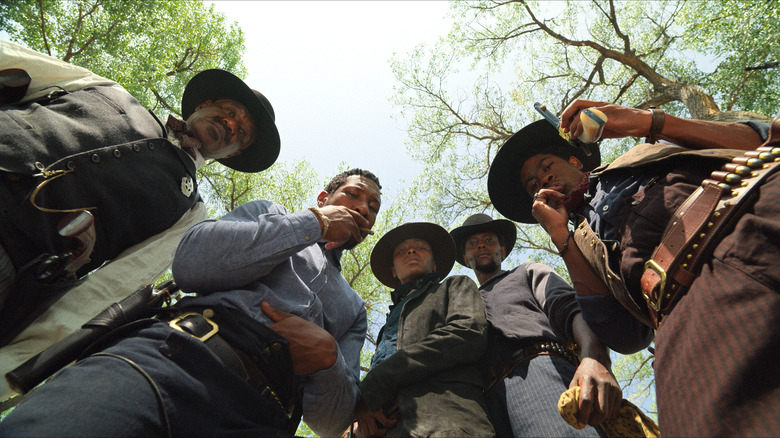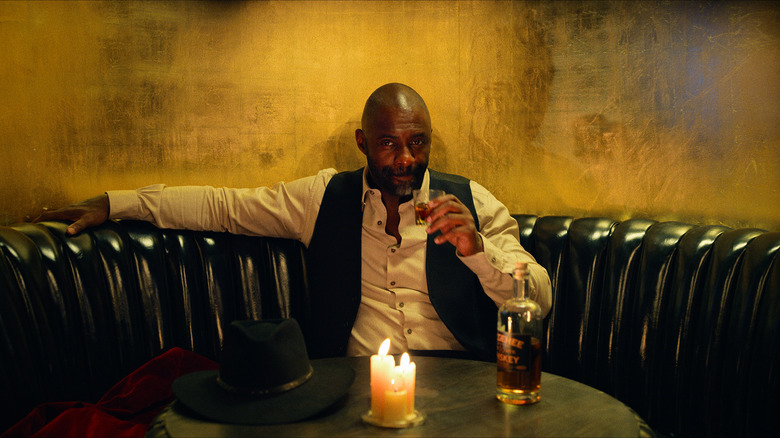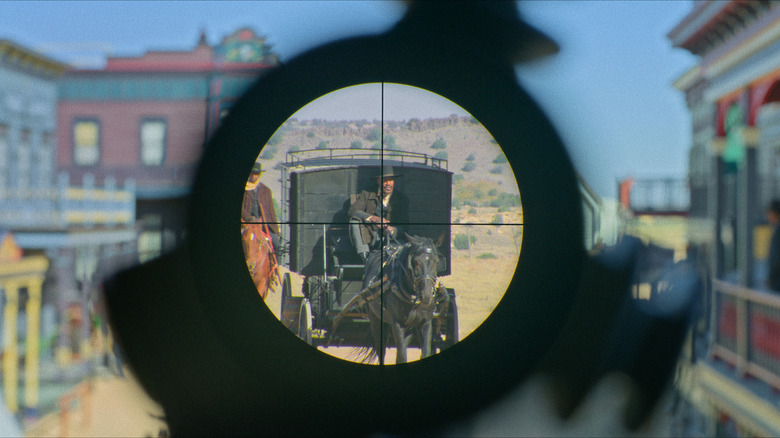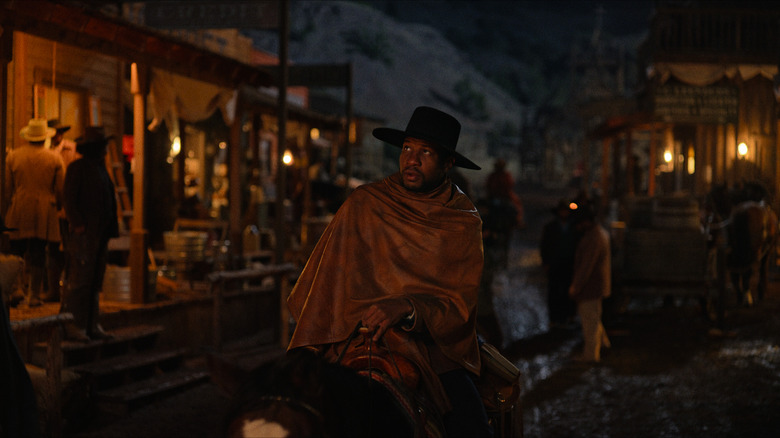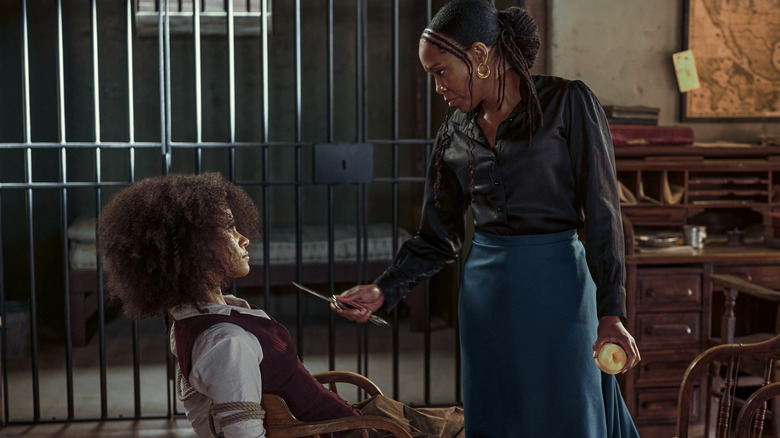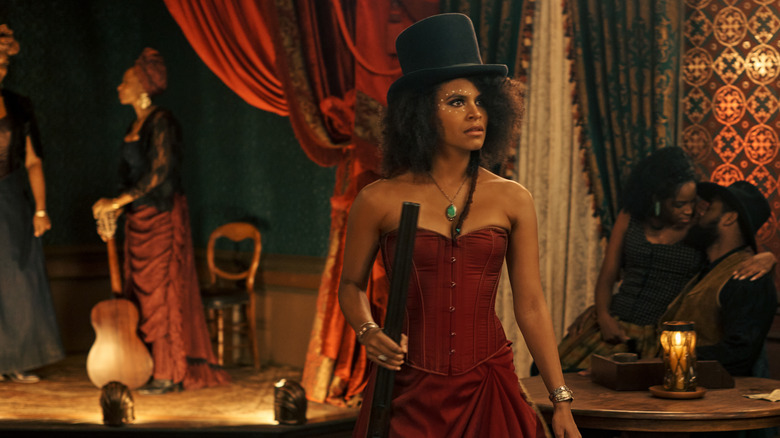An Appropriately Epic Conversation With The Harder They Fall Editor Tom Eagles [Interview]
With "The Harder They Fall," director Jeymes Samuel set out to make a movie for Western lovers and novices alike. His slick and stylish film marries slowburn emotional buildup with dynamic, musical sequences. It juggles nine major players, with an all-star Black cast featuring some of Hollywood's biggest movie stars. Each performer bears the name of a real life cowboy; historical figures reworked into new personalities played by magnetic performers. Toss those elements together and we get a captivating epic, as an outlaw gathers his gang to embark on a deadly quest for revenge.
Editor Tom Eagles was more than up to the challenge of weaving this film together, thrilled to bring Samuel's vision to life despite not being a die-hard Western fan himself. I had the chance to chat with Eagles about the many unique challenges of crafting "The Harder They Fall." In our conversation, he frequently describes the film and process of its creation as fluid — actors ad libbing on the spot, Samuel composing music throughout the process, and scenes coming alive in the edit. All the while, other complicating factors were bearing down: like shooting crowded scenes in the midst of a pandemic, deciding how to pace such a dynamic story, and giving nine leads their time to shine. But who better than to tackle these challenges than the Academy-Award nominated editor behind Taika Waititi's "JoJo Rabbit"?
In our conversation, Eagles talks through the lively creative process, his many sources of inspiration — including "Frasier" and "The Godfather Part II" —and the secret to balancing scene-stealing movie stars.
"If you've got a really good storyteller telling a really good story, what more do you need?"
Jeymes is obviously a long time fan of the genre and I've spoken to a couple other cast members, who had different levels of love for Westerns or maybe hadn't seen too many before signing on. So I'm curious, what was your experience with and feelings about Westerns going in?
I'm definitely in the latter camp, really. Jeymes always said he wanted to make this for people who really love Westerns and really know Westerns and also for people who don't go to Westerns, traditionally. I grew up in New Zealand and at that particular time, it wasn't like there were a whole bunch of Westerns around, I don't think. We didn't have a TV, but it just wasn't really on the air. Westerns were not my thing growing up and it was kind of a foreign format. So I was fairly... not new to Westerns, but I felt like I had to do my homework when we started. So I was coming from the outside in and finding things to love about the genre. But I'm not a dyed in the wool Western fan.
What was it like for you then, coming from the outside in and watching them to prepare? And then finding the balance of taking from them but also not exactly doing that?
We took from them, but we also cast the net wider. Like, Sergio Leone was useful for the kind of interplay of music and sound and picture, which is really important in this film. Peckinpah was useful for the orgy of violence that you have at the end and inter-cutting slow-mos. And also that sense of inevitable violence. I think about Peckinpah and "Billy the Kid" sometimes, which was actually a film I saw growing up. But we also just cast the net wider, this is the only movie I can think of that has references to Malcolm X and Frasier in the same movie — and that tells you everything you need to know about Jeymes.
We talked about "Smoke," for example, '90's Wayne Wang movie, because we had a lot of storytelling scenes in this movie. Regina King, Trudy Smith's great story that she tells to Mary. And Idris has a great story. There's a great storytelling scene at the end of "Smoke" between Harvey Keitel's character, and I forget which Hurt, it's William Hurt, right? And it's really just a slow push in on Keitel and a few cuts back on him listening. And that was encouraging to go back and look at those movies because in my mind, I had populated that out with a flashback. And we did have a flashback for Idris' story. We could have gone there and that was what was scripted, that we should use the flashbacks.
But once I saw the performances coming and I had Idris Elba, then the only thing I really wanted to cut to was Jonathan listening. It was very important what he understands when, in that story. And so it was encouraging to go look at a movie like "Smoke" and see how simple it was and to know that if you've got a really good storyteller telling a really good story, what more do you need? You don't need to see anything else.
Right, so with Idris and Jonathan.... Overall, you have this wide cast, you have nine major players and then some more, so how were you balancing all those storylines?
It was hard. It was really hard. To begin with, the opening act of the film was bouncing around all of those characters, all in their disparate places before they'd converged. So you didn't even know who was on which team. And it got very confusing and we added some kind of complicated plotting around it, Redwood debt plot device, which wasn't really helping us. So really reducing all of that down. We held off introducing the Buck gang until almost the second act. We'd introduced Idris (Rufus) up front, and then it was all about him. It was people talking about him but not seeing him until the big metal box that he's in opens. But what that did was it allowed us to give each character, instead of just dropping into a scene and you've got three or four characters to get to know, we made sure each character had their own entrance.
The first time we meet Regina King as she's facing down a train and shooting a guy for using the N-word on her. And the first time we meet LaKeith's character, he's soliloquizing about non-violence and the same with Bill Pickett and Jim Beckwourth, RJ and Edi. We cut out earlier material of them just talking so that first time we meet Bill, he's singing and picking off characters, picking off these Crimson Hoods from behind the rocks. And then RJ's entrance is a big reveal. Wiley Escoe, Deon Cole, his first entrance into the movie is this piece to camera.
So all of those things were discoveries in the edit because we had a lot more material of those people. It's just what is the best entrance to really cement those characters in your mind? And then we just had to invest time with them. So it's important, given what happens at the end of the movie, that we invest in RJ's character and we find the charm and the humor in him. And the same goes for all of them. It was just a balancing act of keeping all of those balls in the air throughout the movie.
"It was always fluid. He was always writing and rewriting."
I know you've mentioned in other interviews, veering away from inter-cutting to focusing on the two gangs in large chunks. Can you talk about that?
Yeah, we just talked about the opening act, but even through the second act, we were constantly cutting back and forth between the two gangs. And there was a lot of positioning, everyone getting in place for the final confrontation. And it felt like it was more satisfying if we consolidated a lot of that. We took a lot of material out. Once we'd done that and the film was quite lean, we were crosscutting quite a lot. So we consolidated a lot of those storylines so we would go with one gang and stay with them for a while, for three or four scenes. And it just felt like a deeper, more satisfying approach.
As we were doing that, I was watching "The Godfather II" DVD and Walter Murch was talking about how they tested the film, that movie, with a lot more inter-cutting between the past and the present, the Pacino and the De Niro storylines. And they found the same thing, that they really needed to consolidate and allow people to settle into each story and follow that for a while before cutting back across to the other gang.
There's also that interesting mix of the slow Western build up and then the dynamic musical focused editing. I'm curious about any conversations you had with Jeymes about the pace and how you were thinking about pacing the film?
I think Jeymes and I were generally on the same page about the pacing. We got some pressure from some people on the team to try and cut everything fast, make everything fast and entertaining and we had to talk about tension and how tension works. On that second scene of the movie, when Nat Love, Jonathan Majors confronts the fake priest... We had to look at the way that tension works in movies and particularly in a Western, to be confident to hold those shots, to create tension purely by duration, sometimes. You know what's going to happen, you know it's not going to end well, but you don't know when or exactly how, and that's the fun of it.
And then we get into some very fast cut, entertaining musical lead sequences, especially the big action extravaganza in the end of the movie. So definitely music-led, some of those things. Jeymes had written quite a lot of needle drops into the movie and they weren't necessarily what we used. He wound up writing a lot more originals, but they gave me an idea of... So the Fela Kuti song and the Dennis Brown song, those were both in the script and that gave me a great feeling for what the pace and tone and rhythm should be. Because the Fela Kuti song is wild and crazy and it had a lot of starts and stops, so I was able to play with and start and stop around dramatic moments, so that was fun.
And the Dennis Brown song just had so much swagger to it. As soon as I read that with the gang riding into town, I knew what it was. And then there was all the music that he was writing and that was very fun because it was malleable. So he would give me something, maybe it was just a demo. For the song, My Guns Go Bang, originally just had the beat, it was just all these guns going off and he said, "Look, try this against this gun battle between Bill Pickett and the white folks in the white town, but probably not going to work because it's going to fight with the practical guns." But I found a way to, with a little bit of editing on the track and a little bit of tweaking the pictures, that you could actually make those things fit and you could make the gunshots fall on the beat and it was a satisfying climax to that sequence.
There's a lot of that, the gunshots or what have you, matching the beat. Was it more difficult with those songs that you maybe didn't have when you started putting it together and then you'd get them? Was it a big process of changing your original edit?
[Laughs] Yeah, always. There's always a lot of re-editing because I would use temp music. I wouldn't cut to the temp music, but I would cut the temp music to fit the picture. And that was useful because it gave us even just the broadest, "This is where we're going to have music, this is where we're going to have sound design."
And then sometimes, it was hard for Jeymes as director and composer because sometimes he would really love the temp music as a director, but he had to come up with something original. So I would always give him the option of watching it without music. And then the music that came in from him was always a little bit malleable because we would have stems. We were able to make the music and the pictures work in sync. So we were able to cut and paste bits and pieces, maybe we'll take the end of the song and put it in the middle. Or the piece of music, like when Nat Love rides into town and we have the answering shots from Idris, we didn't really have anything for that, so I was able to take little bits and pieces of the stems and find some shots on Idris that just answered the big cable cam shot that we had. It was always fluid. He was always writing and rewriting, giving me things. I would cut them, I would cut the pictures, he'd rewrite to that. And then eventually we got our music editor, Clint Bennett, on as well. He was able to take that much deeper. So it was a real process.
"I always like it when the director's wearing multiple hats."
Did it alter the process a lot to have your director also be the composer?
Jeymes was pretty good about... We did do it in stages. Some things we had to have up front, anything that was synced. Obviously he had to write early on like Mary, Zazie Beetz's character, her song or the Blue Lady Song. But a lot of the other stuff, we did focus on the story, trying to get the story right, trying to get the tone and the rhythm right, and then he started really composing in a big chunk towards the second half of the edit.
I mean, yeah. I felt like I had to work hard to demonstrate if there was a moment that could just be sound design. So I would temp a lot of that stuff and try to do reasonably good temp sound design like Trudy versus the train. When the train is bearing down on Trudy and it's this big noisy thing and we cut to her and it's very still and peaceful. That whole sequence, that train sequence, I worked quite hard on the sound there to hold the space for sound. Because Jeymes was writing all this amazing music, there was always a risk in my mind, at least that it would just be wall-to-wall music. So I had to get in there quick [laughs] and do some temp work to hold that space until Richard King, the sound designer, came and then it really started to sing.
But I always like it when the director's wearing multiple hats, like a writer-director, because it's less people to convince or work with. If you have an idea or you want to change something, it's just one person to kind of go, "Hey, do you like it? Do you not like it?" And so it was just one more thing that was concentrated.
You mentioned that some of the needle drops were scripted. Was that true for most of the music or were there moments where there was scripted music and you decided there shouldn't be or vice versa?
I'm trying to think... Most of the needle drops that were scripted became something. I don't think we dropped anything that was in the script, but there were a lot more things, there were tunes that I probably can't tell you about because Jeymes probably wants to use them in another movie, but things changed. So a lot more stuff became originals that had been scripted as a needle drop.
"She probably bought herself more time in this movie than maybe anyone."
Spoilers for "The Harder They Fall" below.
There are some really great split screen moments, like in that final battle or when we see the death of RJ Cyler's character and we get to see everyone's reaction. Are those things that were in the script or when did you decide to use those?
Yeah, Jeymes always wanted to do those two split screen moments. The other one is on the train. That last one that you're talking about when RJ dies, he was very particular about what it was. So we worked really hard even in pre, we got to Santa Fe a couple of weeks early, we were cutting in Santa Fe, and I actually worked with the assistants just with stock pictures to try and get that right, to get the rhythm right.
So that was very specific and then the other one, which is Cherokee, LaKeith, talking through the wall to the General on the train, that was a little bit more like, "I want split screens here, you figure it out." I think he was specifically, he did want it to wipe on, and then I just had to figure out how to cut a scene where can see both sides. Which is a tricky thing for an editor because normally you're always directing the audience's gaze a little bit. With split screens you can suggest but you can't tell them exactly where to look.
Because LaKeith was so magnetic, I would use cuts to sometimes try and draw your attention over to the other side, we needed to see what was going on there. And the other thing that was tricky about that is LaKeith is a very fluid performer, so he doesn't say the same thing twice ever. So those things were not shot at the same time, when he was doing the general side, he didn't do all that stuff about "Dred Scott free," he didn't do the countdown at the end. So I had to find bits and pieces that I could play on the general side that made it look like they were part of the same conversation.
And then there were just fun discoveries, I found that we could also wipe off with the movement of the door. So that was really fun and Jeymes told me to look at Brian De Palma for split screens. He's a big De Palma fan so I went back and looked at "Dressed To Kill" and a couple other De Palma's, and "Carrie," to see how those worked.
It's funny that you mention wanting to look at LaKeith in those moments since there are so many of those stars in this movie, where you want to be looking at Idris Alba or Jonathan Majors, always. There are all these magnetic performers. How were you juggling that?
To a degree, people buy their own screen time. Do you know what I mean? It's not just if they're doing something great, if they're doing the right thing for the scene at that point in time. There was a lot of adlibbing in the movie. Jeymes was fairly loose, he let people come up with their own sayings and there was one scene where we lost Idris early, so the whole scene wound up having to be adlibbed.
But that scene in particular, that's the scene where Nat Love rides in to try and rescue Mary and is asking for Idris, Rufus' character and Trudy, Regina King's character, holds them off and everyone was adlibbing in that scene, but she was doing the right thing for the character, so that became Trudy's scene.
To a degree, it's just down to the quality of the performers. I think she probably bought herself more time in this movie than maybe anyone. Some of those scenes that she has — where she's telling her story, for example —theoretically could have gone and the story would still have made sense. But her performance was so on. We joked about how it could go, but we never seriously considered chopping that scene because she does it so well.
I'd love to hear you talk more about that, the last 30 minutes where we have this big fight scene happening and everyone's having their moments and we're putting all these pieces together.
Yeah, that was hard because it was coming in, in little dribs and drabs all throughout the shoot and they were a little bit disconnected. Sometimes it would be stunt doubles shooting with second unit. And then once I had it all, it was a question of... Jeymes was from the get-go not too attached to the structure of the script. He said we structure it how we need to structure it. So to find a way to just keep everyone, although they split up into their separate corners of the town and they're all doing different things, to keep them on the same page, emotionally.
So we have the really fun part of it, that is cut to that Fela Kuti song and the heart of that is Mary versus Trudy, that fight that feels like it's been building for the whole film. It's really physical and tooth and nail. And it didn't make sense: I think as scripted, we would've had to play some of the deaths through that and that didn't make any sense at all. Once we started to put it together to the music, it just felt like we needed to front load the fun and then move into another section that was more about emotion. And so that even though they're in separate places, they're all on the same page emotionally, leading you up to the final emotional moment between Rufus and Nat, Idris and Jonathan. So that was the kind of process, a little bit of trial and error, but that came together fairly quickly in the few weeks of the edit.
"The limitations that we had with COVID were actually blessings in disguise."
What was, for you, the trickiest scene or sequence to put together?
Trickiest scene? There are always scenes that, in every movie it feels like, where... there's the scene in the bedroom between Nat and Mary. And it's always tricky when you need the scene, but it's a long and complicated scene that needs to reduce and there's limited coverage. So that's a scene that I always wince a little bit when I watch, because I know that I've moved things around. What happened isn't exactly what happened in the dailies. But I hope that plays smoothly for people.
So there are a couple of scenes like that. There's a scene where Delroy Lindo and Jonathan Majors, Bass and Nat, ride out to this waterhole and the rest of the team come and join them. And likewise, there's a lot of material that came out there. We had a whole lot of stuff about, there was a dead body in the carriage that they had to go and bury. Those were two separate scenes and we combined them into one scene. And we were also looking in that scene for a moment, although it's generally about the gang recombining, where to find a moment to play the intimate moment between the Nat and Mary, because we had to keep that relationship alive and to keep that fairly central to the storyline, so that you could feel some hope for them at the end of the movie. So there were just a lot of balls to keep in the air whilst compressing and rearranging things that weren't where they were supposed to be in the script or in the shoot.
Was that also true of the bar sequence? I know that was complicated because of COVID protocols and so on.
Some of those complications helped us in a way. And I think that's one case. According to the camera guys at least, they wound up shooting those super closeups because they were trying to figure out a way to shoot around COVID restrictions. They couldn't pack the bar out full of people and so we got all of these tights. And through the first half of the song, I felt like those are great punctuation points, the cards going down on the table or the beer flagons meeting and smashing.
But then also what you had, was these beautiful, intimate, close ups between Nat and Mary and I thought, "Once they've seen each other, let's stay in there, let's stay super tight." And it's this across the crowd, literally across crowded a room, their eyes meet and it's this super intimate moment between them in the middle of a song and dance number. So I think in a way, that was a gift.
The other gift that we got from COVID was that scene I was talking about earlier. Rufus and Nat were supposed to meet for the first time as men, as grownups in the street outside the prison and they'd already shot the prison scene and I was cutting it and I thought, "This is actually a great entrance for Idris. This is a great place for these two to come face-to-face." And I had my assistant John, because I can't whistle for sh*t, so I had my assistant John whistle that tune through that opening steadicam POV that Idris comes in on. And it's not John any more, it's actually Jeymes' whistle in the movie. But it gave you the sense of, "How does he know that tune?" Laying down a little bit of groundwork for what happens later.
And I was excited to show Jeymes, I was also a little bit nervous because it's a departure from form. I got on the phone to him and he was like, "Oh look, this terrible thing has happened, we lost Idris a day early. So that can't be the scene that those two men meet." And he said to me, "But I think the prison scene is a better scene." So it's like, "Great, let me show you what I've done." And he loved it.
So I think sometimes, the limitations that we had with COVID were actually blessings in disguise and a tribute to Jeymes, that he's a really flexible filmmaker. Like, he will see that stuff and roll with it. He was disappointed at the lack of people in the saloon, so we did go back and shoot some people to put into the wide shots. But that was about the only place where he was bummed out by the restrictions that COVID put on us. Otherwise, he would take something and run it and turn it into an advantage for us.
"The Harder They Fall" is currently streaming on Netflix.
